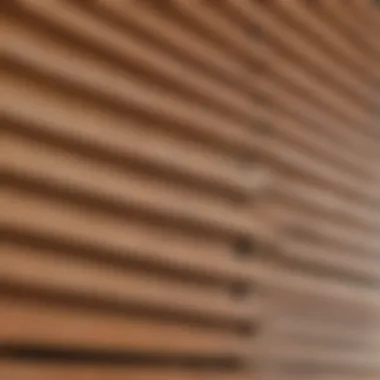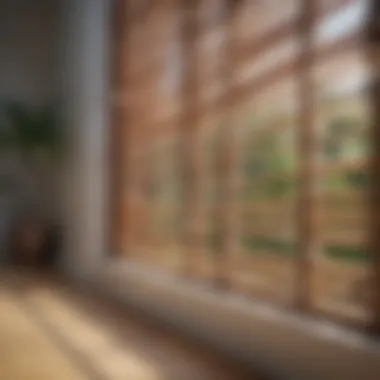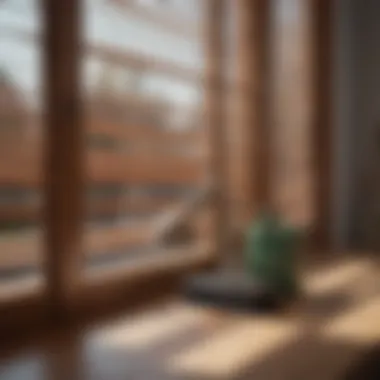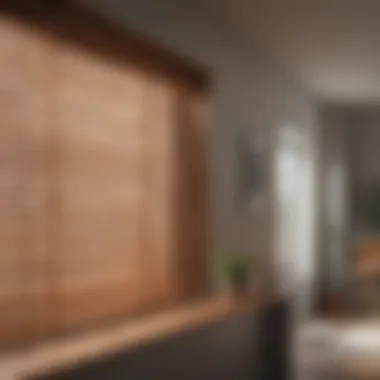A Comprehensive Guide to Washing Wooden Blinds


Intro
Wooden blinds are not just window treatments; they’re a blend of practicality and aesthetics. For homeowners who appreciate a touch of nature indoors, these blinds can elevate the aesthetic while serving a functional purpose. However, like any stylish addition to your home, they demand attention in terms of maintenance. Keeping wooden blinds looking pristine might seem like a chore, but it truly doesn't have to be a headache. Proper care not only boosts their appeal but also extends their lifespan.
This article works to break down the process of cleaning wooden blinds step-by-step. With a variety of pre-cleaning preparations, cleaning techniques, and ongoing maintenance tips, we aim to equip you with all necessary knowledge to care for this beloved home fixture.
You'll learn how to keep those wooden slats free from dust, grime, and damage. With a mix of eco-friendly cleaning solutions and gentle methods, you can ensure your blinds maintain their beauty without compromising their integrity. Whether you're a homeowner looking to refresh your living space or someone who simply enjoys home decor, this guide is here for you.
So let’s delve into effective methods for keeping wooden blinds fresh and appealing!
Understanding Wooden Blinds
Wooden blinds offer much more than just a way to filter light or maintain privacy. They're like the unsung heroes of interior decor, providing both function and style. Understanding the various aspects of wooden blinds is crucial, especially for anyone looking to maintain the beauty and longevity of these treatments. They can transform a room, adding warmth and elegance while being practical. Knowing the different types and benefits of wooden blinds can aid homeowners, interior design enthusiasts, and those with a knack for home decor in making informed choices.
Types of Wooden Blinds
Horizontal Blinds
Horizontal blinds are one of the most common styles you’ll encounter in homes. This design consists of slats arranged horizontally, allowing for precise light control. The main draw of horizontal blinds is their versatility; they can suit a variety of window sizes and architectural styles, making them a popular choice for many settings. One standout characteristic is how easy they are to clean compared to other styles, which is a huge plus when discussing maintenance—especially pertinent for this guide. However, one needs to handle these slats with care, as they can be prone to bending if mishandled.
Vertical Blinds
On the other hand, vertical blinds bring a different flavor to window treatments. Perfect for sliding glass doors or large windows, these blinds have their slats aligned vertically. One key advantage of vertical blinds is that they can give the illusion of taller ceilings, making them an appealing choice for small rooms. They also allow for easy opening to one side, letting in plenty of natural light when needed. Yet, they might not be everyone's cup of tea, as they can take up more space and might not fit well with smaller windows. Understanding these nuances helps in choosing the right type for your specific needs.
Shutters
Shutters are like the upscale cousin of blinds. They are usually made from solid wood and can be fitted directly onto the window frame. One of the most appealing aspects of shutters is their ability to offer both aesthetic charm and effective light control. They create a solid barrier when fully closed, providing excellent privacy and insulation. However, installation can often be more involved and typically comes at a higher price point, which could be a deal-breaker for some. Their durability is one of their significant advantages, but they do come with the caveat that regular maintenance is a must to keep them looking their best.
Benefits of Wooden Blinds
Aesthetic Appeal
When it comes to aesthetic appeal, wooden blinds are hard to beat. Their natural texture and finishes add a touch of sophistication to any room. Whether you're going for a rustic look or a more modern vibe, wooden blinds can seamlessly integrate into almost any decor style. One unique feature is how they lend warmth to a space, inviting a sense of home. However, one must be cautious, as they can show wear over time if not taken care of properly.
Energy Efficiency
Energy efficiency is another area where wooden blinds shine, literally and figuratively. They act as natural insulators, helping maintain a consistent indoor temperature. By regulating heat and light, wooden blinds can potentially reduce energy costs, making them a savvy choice for the eco-conscious homeowner. While they may be an initial investment, the long-term savings could outweigh the cost, particularly during extreme weather seasons.
Durability
Durability is a hallmark quality of wooden blinds. Unlike fabrics that may fade or tear, well-crafted wooden blinds can withstand the test of time, especially when properly maintained. This resilience makes them a sound investment for anyone wanting lasting value. However, the materials' susceptibility to humidity and warping means that they may require adjustments in high-moisture environments, like kitchens or bathrooms.
Wooden blinds aren’t just for looks; they're a functional addition to any home, offering a blend of style and substance.
Preparing for Cleaning
Before diving into the nitty-gritty of washing your wooden blinds, it's essential to grasp the importance of preparation. This stage sets the tone for the entire cleaning process, ensuring that you're equipped with the right tools and an understanding of what you're dealing with. Proper preparation not only makes the task easier, but it also protects your blinds from potential damage while maximizing your effort in achieving that pristine look.
Gathering Necessary Supplies
When it comes to washing wooden blinds, having the right supplies can be the difference between a job well done and a frustrating experience. Let's break down the essentials:
Microfiber cloths
Microfiber cloths are a staple in any cleaning arsenal, particularly for delicate surfaces like wood. What sets them apart is their unique ability to trap dirt and dust without scratching the wood. Made of fine fibers, they're not only effective but also gentle. They'll help lift grime without leaving behind a trail of lint. The key characteristic that makes microfiber cloths a beneficial choice is their absorbency. They can hold multiple times their weight in water, which makes them ideal for both wet and dry cleaning.
Moreover, these cloths can be washed and reused, making them an eco-friendly option. However, it's crucial to avoid using fabric softeners when washing them, as this can reduce their effectiveness.
Mild detergent
Using a mild detergent is all about choosing a cleaner that won't harshly strip the finish of your wooden blinds. A gentle, biodegradable detergent will work wonders, breaking down grime while being kind to the wood. The standout feature of mild detergents is their low toxicity compared to harsher chemical cleaners, which can cause damage or leave behind a residue that attracts dirt. This makes them a popular choice for maintaining wooden surfaces.
It's worth noting, however, that even a mild detergent should be tested in a small, inconspicuous area first. This helps to ensure that it doesn't cause any discoloration or adverse reactions with your specific type of wood.


Water
Water is perhaps the simplest yet most crucial element in your cleaning arsenal. It acts as a solvent, allowing both your microfiber cloth and mild detergent to work effectively together. The purity and temperature of water can make a difference. Using lukewarm water tends to yield better results, as it helps to dissolve dirt without damaging the wood.
However, one must exercise caution; excess moisture can warp or damage wooden slats. Therefore, wringing out cloths thoroughly before use is always wise. Balance is key here.
Assessing Blind Condition
Before you start scrubbing, it’s important to assess the condition of your blinds. This can save you time and ensure a more successful cleaning.
Identifying damage
Identifying any damages before cleaning is paramount. Cracks, warps, or loose slats can easily be exacerbated through cleaning techniques if not noticed first. By taking the time to inspect each slat individually, you can address any issues proactively. For instance, a small crack might require a bit of wood glue before you begin the washing process, ensuring your blinds don’t face further risk during cleaning.
Spotting these imperfections allows for a more careful approach, prioritizing repair over mere cleaning, making it a critical step in prolonging the lifespan of your blinds.
Checking for discoloration
Similarly, checking for discoloration should be part of your pre-cleaning routine. Fading can signify prolonged exposure to sunlight or exposure to harsh chemicals. By observing any areas of discoloration, you can alter your cleaning method or solution accordingly, using gentler products in those spots or providing additional care. Plus, this moment allows you to consider any refinishing options if needed. Addressing these matters head-on sets you up for success and affirms your commitment to maintaining your blinds diligently.
Remember: Preparation is half the battle. Taking these proactive steps ensures your wooden blinds stay looking their best for years to come.
Cleaning Techniques
Cleaning wooden blinds effectively is paramount not just for aesthetics but also for extending their lifespan. Wooden blinds can collect dust and grime, which if left unchecked, can lead to more significant issues or damage. Knowing the right techniques can save time and effort while ensuring that the blinds look their best. Here are some effective cleaning methods:
Dusting the Blinds
Dusting is the first step in maintaining the appearance of wooden blinds. Removing dust not only enhances their visual appeal but also prepares them for deeper cleaning later on.
Using a microfiber cloth
Using a microfiber cloth is often touted as one of the best methods for dusting wooden blinds. Why, you might ask? Microfiber is designed to trap dust and dirt rather than just push it around, making it efficient at cleaning.
- Key Characteristic: The unique fiber structure creates a larger surface area that is adept at capturing particles.
- Benefits: It’s a gentle option that won’t scratch the wood. Plus, you don’t need to use any sprays or chemicals, which fits well with the theme of keeping it clean and simple.
- Advantages/Disadvantages: Although it is effective, the cloth requires regular washing to maintain its cleaning power. If neglected, the cloth can redistribute dust instead of removing it.
Employing a vacuum cleaner
Another effective method is employing a vacuum cleaner with a brush attachment. This technique can be a time-saver, especially for larger window treatments.
- Key Characteristic: A vacuum can reach areas that are typically hard to access. The brush attachment mimics the gentleness of a microfiber cloth.
- Benefits: For those who already own a vacuum, this method requires little extra effort. It's also great for people with respiratory issues, as it prevents dust from becoming airborne.
- Advantages/Disadvantages: While most vacuums are effective, older or stronger models might scratch the wood. Always check the brush head to ensure it’s soft enough for delicate surfaces.
Washing the Blinds
After the dusting phase, washing the blinds becomes essential for more embedded grime.
Preparing a cleaning solution
The preparation of a cleaning solution is a crucial step. You want a mixture that will clean without damaging the wood.
- Key Characteristic: A mild detergent mixed with water often works wonders without compromising the wood finish.
- Benefits: This mixture effectively loosens dirt without leaving harmful residues.
- Advantages/Disadvantages: Be cautious with the proportions; too much detergent can leave a film, while too much water can harm the wood.
Applying the solution
Applying the solution correctly determines how clean your blinds will be. Use a soft sponge or cloth to avoid scratches.
- Key Characteristic: Gently working the solution into any dirty spots helps dislodge stubborn grime.
- Benefits: This method allows precision, creating less mess than other cleaning techniques.
- Advantages/Disadvantages: Take care not to saturate the wood, as this could cause warping or discoloration.
Rinsing techniques
Rinsing is often an overlooked step but it is essential to remove any remaining cleaning solution.
- Key Characteristic: Using a cloth dampened with clean water is typically best practice.
- Benefits: This step ensures that no residue from cleaning agents remains on the blinds, which could attract more dust.
- Advantages/Disadvantages: However, just like in the washing stage, too much moisture can lead to issues. A fugitive approach is wise here.
Drying the Blinds


Last but not least, drying is vital to keep wooden blinds in tip-top shape. Wet wood is a recipe for disaster.
Using a dry cloth
Using a dry cloth can significantly help in the drying phase.
- Key Characteristic: A dry cloth quickly absorbs moisture, preventing warp and decay.
- Benefits: It’s straightforward and requires little effort.
- Advantages/Disadvantages: Ensure that the cloth is clean; otherwise, you could inadvertently spread dirt.
Avoiding excess moisture
Lastly, it’s crucial to avoid excess moisture altogether.
- Key Characteristic: Quick actions in dealing with wet blinds can make all the difference.
- Benefits: Keeping moisture to a minimum maintains the wood’s integrity.
- Advantages/Disadvantages: While a quick wipe can be good, rushing could lead to incomplete drying, which, don’t forget, can create mold or mildew.
Ensuring your wooden blinds are clean doesn't just enhance their beauty; it prolongs their life, creating a win-win situation for your home aesthetics and your investment!
Environmental Considerations
In today's world, being mindful of our environment is more crucial than ever. That goes for cleaning wooden blinds as well. By utilizing eco-friendly methods, not only do we take care of our living spaces but also contribute to the preservation of our planet. Choosing environmentally safe cleaning solutions can reduce chemical runoff, minimize indoor air pollution, and protect household members, including furry friends. In this section, we'll explore some natural cleaning agents and discuss how to avoid harmful substances found in conventional cleaning products.
Eco-Friendly Cleaning Solutions
Vinegar and water
Vinegar mixed with water is a classic solution when it comes to cleaning, and for good reasons. This combination shines through due to its non-toxic nature, making it an excellent option for those who are cautious about introducing harsh chemicals into their homes. Vinegar has natural disinfectant properties, which helps in eliminating dust and grime without leaving behind harmful residues.
Its smell may not be the most pleasant at first, but it dissipates quickly, leaving your blinds cleaner and fresher.
Benefits of vinegar and water:
- Safe for both the environment and your home.
- Cost-effective, as vinegar is inexpensive and easily accessible.
- Versatile—works on various surfaces, not just wooden blinds.
However, it’s worth noting that vinegar can be acidic, so always test a small area first to ensure that your blinds do not react negatively.
Baking soda mixtures
Baking soda is often regarded as a superhero in the world of natural cleaning. Its key characteristic lies in its abrasive nature which proves especially handy when faced with stubborn stains. Mixing baking soda with a bit of water can create a paste that’s perfect for spot cleaning those hard-to-reach places on wooden blinds. Plus, it deodorizes surfaces, making it a two-for-one deal.
Benefits of baking soda mixtures:
- Non-toxic and safe for household use.
- Excellent at neutralizing odors and removing stains.
- Easily customizable—mix with other ingredients like lemon juice for added cleaning power.
That said, over-application can lead to a gritty residue, so remember less is more!
Avoiding Harmful Chemicals
Recognizing harmful substances
Being able to recognize harmful substances in cleaning products is vital for maintaining a safe home environment. Many commercial cleaners contain volatile organic compounds (VOCs) which can lead to respiratory problems and other health issues, especially with long-term exposure. Being informed and vigilant can help you choose products that won't harm your indoor air quality.
Key characteristics of knowing what to avoid:
- Awareness of common harmful ingredients like ammonium and formaldehyde.
- Ability to identify products with clear warning labels indicating potential risks.
- Empowerment to opt for safer, green alternatives instead.
Learning to spot these substances can drastically improve the safety of both your family and your wooden blinds.
Reading labels carefully
Reading product labels may seem tedious, but it is a critical step in ensuring a clean and safe home. Taking the time to assess ingredients and their potential effects can dramatically impact your well-being.
This practice allows you to make informed decisions about products that align with your environmental values and your home's health.
Important aspects of reading labels:
- Understanding what each ingredient does—look beyond marketing hype.
- Searching for certifications on products that indicate eco-friendliness.
- Being aware of deceptive terms like "natural" which may not mean what you think.
In essence, careful label reading sheds light on what goes into the cleaning solutions we use, keeping your surroundings safe and environmentally conscious.
Preventive Maintenance


Maintaining the integrity and appearance of wooden blinds goes beyond occasional cleaning; it involves a proactive approach referred to as preventive maintenance. This practice emphasizes regular care and attention, which can significantly enhance the longevity of your blinds. By implementing preventive maintenance strategies, homeowners are less likely to face severe damage or costly repairs in the long run. Caring for your wooden blinds regularly not only keeps them looking picture-perfect but also protects your investment, allowing you to enjoy their aesthetic benefits for years to come.
Regular Dusting
Establishing a cleaning schedule
An effective strategy to preserve the beauty of wooden blinds is establishing a cleaning schedule. This method ensures that dust and grime do not accumulate, which can lead to deeper stains and potential decay. A regular interval—be it weekly or bi-weekly depending on your living environment—can easily fit into the lifestyle of most homeowners. The key characteristic of this practice is its simplicity. It promotes consistency, which can be a helpful addition to one's overall home maintenance. Given that dust can settle quickly, setting specific days for cleaning helps prevent dust buildup, making it a popular option among homeowners, especially those residing in dustry areas or homes with pets.
Advantages of establishing a cleaning schedule include:
- Reduced cleaning time: Regular maintenance often requires less effort.
- Prevention against damage: Timely cleaning helps catch potential problems before they escalate.
- Promotes a healthier environment: Less dust contributes to better air quality within your home.
In contrast, the downside may be for busy individuals who might find adherence to a strict schedule challenging. However, the benefits strongly outweigh this minor inconvenience. In the end, a little effort every now and then can save a headache down the road.
Using protective covers
Another angle of preventive maintenance is using protective covers. These accessories act as barriers against dust, allergens, and even UV rays that can cause fading. The effectiveness of protective covers lies in their ability to keep blinds clean without requiring frequent cleaning. This is particularly beneficial for those who might not have the time or resources to maintain a rigorous cleaning schedule.
A significant characteristic of these covers is their versatility; they come in various materials and designs, allowing for both function and aesthetic integration into your home decor. The major upsides to protective covers include:
- Ease of use: Covers are usually straightforward to put on and take off.
- Long-lasting protection: They significantly prolong the life of the blinds by reducing direct exposure to harmful elements.
Despite these benefits, there are a few disadvantages worth considering. They may not fit all styles of wooden blinds perfectly, and some homeowners might find them visually unappealing depending on design preferences. However, if chosen wisely, protective covers can blend seamlessly with your overall home aesthetic.
Repairing Minor Damage
Identifying issues early
Catching problems before they balloon into larger ones is yet another crucial aspect of preventive maintenance. Identifying issues early with your wooden blinds means you have a better chance of fixing them affordably and simply. Regular checks can reveal scratches, loose slats, or discoloration. The main virtue of this practice is awareness; homeowners who frequently assess their blinds often spot problems that others might overlook.
The advantage of recognizing issues early can’t be overstated:
- It can save time and money by preventing the need for complex repairs.
- An early intervention can halt further damage, keeping the overall appearance of your blinds— and your space—intact.
Yet, it does require a little vigilance that may not always fit into everyone’s routine. Still, the overall benefits make it an indispensable practice for anyone serious about maintaining wooden blinds.
Methods for minor fixes
Finally, knowing how to address minor repairs is essential in preventive maintenance. Whether it's reattaching a loose slat or applying a wood polish to keep surfaces smooth, having a toolbox with essential items can make all the difference. Methods for minor fixes are appealing due to their simplicity and accessibility.
A remarkable feature of these methods is that many can be completed with everyday household items, making them a cost-effective solution. As an added bonus, tackling small issues often provides a sense of accomplishment and encourages continued care of your wooden blinds.
Some popular minor fix methods include:
- Wood filler for scratches: This easily available product blends swiftly with wooden surfaces.
- Tightening screws: Regularly checking and tightening can prevent blades from drooping.
- Applying wood polish: A simple application keeps the blinds looking fresh and vibrant.
While there are few drawbacks, any repair requires a certain level of comfort with DIY—a skill some may not have. Nevertheless, the simplicity of these methods often encourages homeowners to dive in and learn, enhancing their understanding of caring for their wooden blinds.
An effective preventive maintenance strategy can keep your wooden blinds looking fresh for many years, enhancing both their functional and aesthetic value.
Epilogue
In wrapping up the conversation around maintaining wooden blinds, it’s crucial to stress the importance of regular care and cleaning. Wooden blinds, while undeniably beautiful, can quickly lose their charm if neglected. Regular maintenance not only preserves their aesthetic appeal but also extends their lifespan, allowing homeowners to enjoy their investment longer.
Recap of Cleaning Steps
To keep your wooden blinds in top-notch condition, consider these essential steps:
- Gather your materials: You’ll need microfiber cloths, mild detergent, and water.
- Dust regularly: Use a microfiber cloth or a vacuum cleaner to remove dust and grime that can accumulate.
- Wash carefully: Prepare a gentle cleaning solution, apply it delicately, and be cautious to avoid soaking the blinds.
- Rinse and dry: Make sure to rinse off all detergent residues and dry with a clean cloth to avoid any water damage.
- Implement preventive measures: Set a regular cleaning schedule and keep an eye out for any wear and tear.
Sticking to these steps can seem straightforward, but their impact on the longevity and appearance of your blinds is substantial.
The Importance of Care
Caring for wooden blinds goes beyond just aesthetic considerations; it enhances the durability and functionality of your window treatments. Regular cleaning prevents dirt and grime buildup, which can lead to discoloration and damage over time. It’s about acknowledging the role of wooden blinds not just as decorative elements but as components of your home’s environment that contribute to comfort and efficiency.
By showing some TLC (tender loving care) toward your blinds, you’re ensuring that they remain a beautiful part of your home for years to come. In essence, proper maintenance and cleaning are not just chores; they are invitations to appreciate the craftsmanship and beauty of wooden blinds.
"Investing time in proper maintenance translates into long-term savings and satisfaction."
Beneath the surface, the message is clear: treating your wooden blinds with respect and care is not merely practical, it’s fundamental to maintaining a harmonious home environment.



